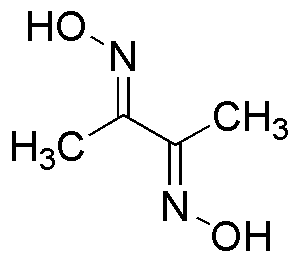Dimethylglyoxime is widely utilized in research focused on:
- Analytical Chemistry: It serves as a chelating agent for nickel, allowing for precise detection and quantification in various samples, which is crucial for environmental monitoring and quality control in manufacturing.
- Coordination Chemistry: Dimethylglyoxime is used to synthesize nickel complexes, which are important in catalysis and material science, providing researchers with valuable insights into metal interactions.
- Pharmaceutical Development: Its properties are leveraged in drug formulation processes, particularly in stabilizing active pharmaceutical ingredients, enhancing their efficacy and shelf life.
- Food Industry: It is applied in food analysis to detect trace amounts of nickel, ensuring compliance with safety regulations and protecting consumer health.
- Educational Laboratories: Dimethylglyoxime is commonly used in teaching labs for experiments related to coordination compounds, helping students understand complex chemical interactions in a hands-on manner.
General Information
Properties
Safety and Regulations
Applications
Dimethylglyoxime is widely utilized in research focused on:
- Analytical Chemistry: It serves as a chelating agent for nickel, allowing for precise detection and quantification in various samples, which is crucial for environmental monitoring and quality control in manufacturing.
- Coordination Chemistry: Dimethylglyoxime is used to synthesize nickel complexes, which are important in catalysis and material science, providing researchers with valuable insights into metal interactions.
- Pharmaceutical Development: Its properties are leveraged in drug formulation processes, particularly in stabilizing active pharmaceutical ingredients, enhancing their efficacy and shelf life.
- Food Industry: It is applied in food analysis to detect trace amounts of nickel, ensuring compliance with safety regulations and protecting consumer health.
- Educational Laboratories: Dimethylglyoxime is commonly used in teaching labs for experiments related to coordination compounds, helping students understand complex chemical interactions in a hands-on manner.
Documents
Safety Data Sheets (SDS)
The SDS provides comprehensive safety information on handling, storage, and disposal of the product.
Product Specification (PS)
The PS provides a comprehensive breakdown of the product’s properties, including chemical composition, physical state, purity, and storage requirements. It also details acceptable quality ranges and the product's intended applications.
Certificates of Analysis (COA)
Search for Certificates of Analysis (COA) by entering the products Lot Number. Lot and Batch Numbers can be found on a product’s label following the words ‘Lot’ or ‘Batch’.
*Catalog Number
*Lot Number
Certificates Of Origin (COO)
This COO confirms the country where the product was manufactured, and also details the materials and components used in it and whether it is derived from natural, synthetic, or other specific sources. This certificate may be required for customs, trade, and regulatory compliance.
*Catalog Number
*Lot Number
Safety Data Sheets (SDS)
The SDS provides comprehensive safety information on handling, storage, and disposal of the product.
DownloadProduct Specification (PS)
The PS provides a comprehensive breakdown of the product’s properties, including chemical composition, physical state, purity, and storage requirements. It also details acceptable quality ranges and the product's intended applications.
DownloadCertificates of Analysis (COA)
Search for Certificates of Analysis (COA) by entering the products Lot Number. Lot and Batch Numbers can be found on a product’s label following the words ‘Lot’ or ‘Batch’.
*Catalog Number
*Lot Number
Certificates Of Origin (COO)
This COO confirms the country where the product was manufactured, and also details the materials and components used in it and whether it is derived from natural, synthetic, or other specific sources. This certificate may be required for customs, trade, and regulatory compliance.


